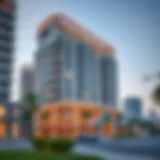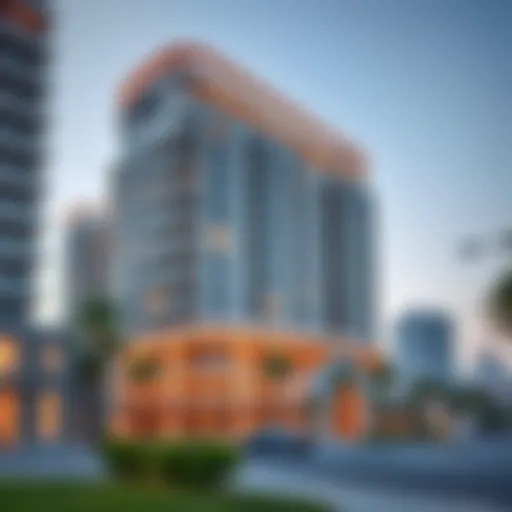In-Depth Weather Insights for Al Quoz, Dubai


Intro
Al Quoz, a dynamic and diverse district nestled within the bustling landscape of Dubai, showcases a unique blend of urban living and cultural richness. Known for its industrial roots, Al Quoz has transformed over the years into a vibrant hub attracting residents, visitors, and enterprises alike. With its eclectic mix of art galleries, cafés, and parks, the area's weather patterns have significant implications for daily life and community activities. This comprehensive outlook on Al Quoz's climate serves as a roadmap for navigating its distinct seasonal variations, temperature changes, and rain forecasts, enhancing the everyday experiences of homeowners, planners, and visitors.
Neighborhood Features
Exploring Al Quoz necessitates understanding its neighborhood features, which significantly influence the area's climate.
Landscaping Highlights
The landscape in Al Quoz is far from ordinary. You find a myriad of lush green spaces, like Al Quoz Park, providing a much-needed respite amidst the urban hustle. The meticulous landscaping blends native plants with more exotic flora, creating microenvironments that can affect local humidity and temperature. These green spaces not only enhance the aesthetic appeal but also play a crucial role in regulating heat.
- Succulents and cacti thrive in the arid climate, requiring minimal water; they are often used in private gardens and commercial spaces.
- Misting systems and shaded seating areas in parks help locals enjoy the outdoors, even as temperatures soar.
Architectural Styles
The architectural landscape of Al Quoz mirrors its evolving character. From modern warehouse conversions to traditional Emirati homes, the buildings here are designed to withstand the region's climatic challenges. Many structures utilize materials that reflect sunlight, maintaining cooler indoor temperatures.
- The industrial warehouses, often transformed into art studios, showcase a raw elegance, rich in character that reflects the district's creative side.
- Contemporary residential developments prioritize energy efficiency, featuring large windows to harness natural light while offering panoramic views of the surrounding areas.
Community Life
Community life in Al Quoz is dynamic, punctuated by events and amenities that cater to diverse interests. The local weather significantly influences the rhythm of life here, making it essential to understand its nuances.
Local Events and Activities
A multitude of local events happens throughout the year, with many relying on favorable weather conditions. From arts festivals to farmers' markets, Al Quoz buzzes with activities targeting all age groups. Popular events include:
- Art Dubai, showcasing regional artists and international talents, attracting art enthusiasts from all over.
- Food festivals often held in cooler months allow locals to sample delicacies from various cuisines.
Lifestyle Amenities
Amenities in Al Quoz complement its community fabric. Cafés, galleries, and wellness centers abound, offering ideal spots for relaxation after a long day. As the sun sets, outdoor venues come alive, with diners enjoying meals in pleasant temperatures, especially during winter.
- Fitness centers often host outdoor classes, taking advantage of the temperate months.
- School gatherings and cultural events draw families, reflecting the area's cohesive atmosphere.
Al Quoz stands as a testament to Dubai's ability to merge functionality with creativity, all within the constraints of its climate.
Understanding these elements, particularly the localized weather trends, is paramount. Insights into temperature fluctuations and rain forecasts empower residents and visitors alike, enabling them to thrive in this vibrant corner of Dubai. By appreciating not only the climate but the lifestyle it fosters, one can truly engage with the essence of Al Quoz.
Understanding Al Quoz: A Brief Overview
Al Quoz, a district nestled within the bustling city of Dubai, represents more than just a location on a map. Its significance stretches far beyond geographical boundaries, delving into the heart of urban life and culture in this vibrant region. As a rapidly developing area, understanding Al Quoz becomes essential for homeowners, visitors, planners, and architects alike. Recognizing its unique characteristics offers numerous benefits, from effective planning strategies to appreciating the local community's lifestyle.
To navigate daily life here, one must grasp not just the physical environment but also the evolving urban landscape and its implications on housing, commerce, and social dynamics. This article lays out a detailed examination of Al Quoz, peeling back the layers of its urban development and unique geographical positioning to highlight the myriad ways it shapes both the local and broader Dubai context.
Geographical Significance
Al Quoz is strategically positioned, acting as a bridge between Dubai's commercial heart and its burgeoning residential regions. Bounded by major thoroughfares, this district benefits from excellent connectivity, making it an attractive spot for both businesses and families. The landscape here is a mix of sprawling warehouses, art galleries, and luxurious residences, a duality that speaks to its evolving nature.
The location is critical for understanding the weather patterns in Al Quoz. It lies inland, which subjects it to the extremes of the desert climate. The temperatures can soar, especially in the summer months, reaching upwards of 45°C. The area's proximity to the ocean also means that when weather systems shift, conditions can change rapidly, affecting daily life significantly.
This location not only impacts the climate but also influences local flora and fauna. The intertwining of urban and natural elements gives character to Al Quoz, making it a site where one can experience the interplay of Dubai’s growth amidst ecological considerations.
Urban Development in Al Quoz
Urban development in Al Quoz is a tale of rapid transformation. Once characterized solely by its industrial warehouses, the area has evolved markedly over the years. Today, it boasts an eclectic mix of residential options, art installations, and commercial spaces that reflect the diverse ambitions of its inhabitants.


As corporate entities flock to the district, the landscape is becoming increasingly commercialized. New residential complexes and shopping districts spring up, catering to a contemporary lifestyle that seeks a balance between work and leisure. Trends in architecture reveal a shift towards sustainable building practices, often incorporating renewable energy sources and green spaces.
This development brings forth several considerations:
- Planning for the Future: With the rapid changes, urban planning requires foresight. Ensuring adequate infrastructure, transportation networks, and public amenities is crucial to maintaining the quality of life in this thriving locale.
- Balancing Growth with Localization: The influx of expatriates and businesses has necessitated the preservation of Al Quoz's cultural identity. Local events and art fairs play a vital role in anchoring the community to its roots, blending modernity with tradition in an intriguing manner.
- Weather Resilience: As development progresses, attention must also focus on climate resilience. Innovations in building materials and designs can help mitigate the extreme weather conditions typical of the region, ensuring sustainability for generations to come.
Understanding these dynamics is not merely academic; it empowers residents and planners to make informed decisions about their environment, fostering a sense of stewardship over this unique district.
Current Weather Conditions in Al Quoz
Understanding the current weather in Al Quoz is vital not only for day-to-day activities but also for long-term planning. Accurate weather reports can guide residents and visitors making decisions concerning travel, outdoor activities, and even architectural planning. In a city like Dubai, where the sun can be relentless and temperatures can soar, knowledge about present conditions is indispensable. Whether you're a homeowner looking to water your garden, a tourist wishing to explore local attractions, or a city planner assessing the effects of climatic variations on buildings, having a deep grasp of current weather conditions helps in making informed choices.
Temperature Analysis
Temperature in Al Quoz can be quite variable depending on the time of year. Generally, the area experiences high temperatures especially during the summer months. It’s not uncommon for thermometers to creep above 40°C. The hot season extends from May to September, and during this period, the heat can be more than just a minor inconvenience.
During October through April, temperatures drop, offering a much milder climate, perfect for outdoor activities and social events. Daytime highs can hover around 24-30°C, making it an ideal time for visitors and residents alike to enjoy parks and open-air markets. Reports indicate that the diurnal temperature variation can also be significant, with nights cooling down rather quickly compared to daytime heat.
Humidity Levels
Alongside temperature, humidity levels in Al Quoz can greatly influence comfort and activities. Typically, humidity levels range significantly throughout the year. During the summer, when temperatures peak, humidity can also be high, sometimes exceeding 60%. This can lead to a muggy feel, making the heat feel even more intense.
In contrast, the cooler months experience lower humidity levels, often around 50%-55%. This drop can provide a respite from the sweltering summer, making outdoor events more pleasant. It’s also worth noting that higher humidity can affect not just comfort but also performance in various activities such as sports or other outdoor commitments. Residents might want to consider their plans during high humidity days.
Wind Speeds and Directions
Wind patterns in Al Quoz play a considerable role in shaping the local climate and overall feel of the place. Usually, the breeze tends to be gentle; however, it can pick up speed, especially during certain seasons. Average wind speeds hover between 15-25 km/h, which can be refreshing in the heat.
Wind direction also varies, commonly blowing from the Arabian Gulf, bringing in some relief during summer. During winter months, winds might shift and come from the land, causing temperatures to drop further. Notably, understanding wind patterns can also influence architectural designs in Al Quoz, where buildings might be oriented to optimize natural ventilation.
"The interplay of temperature, humidity, and wind can create varying conditions that affect every aspect of life in Al Quoz."
Monitoring current weather conditions will not only help optimize your daily activities but also inform broad planning endeavors in the community. The importance of gathering this type of data cannot be overstated for anyone involved in Al Quoz, whether they are residents, visitors, or professionals engaged in urban development.
Historical Weather Patterns in Al Quoz
Understanding historical weather patterns is crucial for grasping the climate dynamics in Al Quoz. This aspect helps residents and planners engage with their environment more effectively, from anticipating heat waves to preparing for potential rainfall. Recognising these patterns allows for informed decisions regarding construction, irrigation, and outdoor activities, underlining the importance of historical data in shaping daily life in this vibrant district.
Temperature Trends Over the Years
Al Quoz has experienced significant variations in temperature over the years. Monthly averages generally show the summer months, particularly from June to August, hitting the heights near 40°C. In contrast, the winter months can dip down to a more modest average of around 20°C. The average annual temperature tends to hover around 30°C, indicating a region that is predominantly hot, with some fluctuations.
"Historical temperature data paints a vivid picture of climate evolution, indicating shifts that may influence local planning and lifestyle choices."
Recent decadal trends reveal a gradual increase in temperatures, which could be traced back to broader climate change discussions. For example, while recorded temperatures in the early 2000s showed lower peaks, recent years have introduced sustained highs that amplify the heat stress on both residents and infrastructure. This ‘warming pattern’ is not just an idle observation; it holds implications for the local environment, suggesting that architectural designs need to consider better insulation and cooling methods now more than ever.
Precipitation Records
Precipitation is a variable that does not lurk in the background easily, especially in a desert-like region such as Al Quoz. Rainfall is limited but tends to spike in the winter months. Historically, the average rainfall per year is a meager 100 mm, concentrated in a few months, mainly between November and March.
The irregularities in rainfall can create challenges for water conservation. For instance, many residents often note that periods of drought can alternate swiftly with sudden heavy rain, leading either to a shortage or localized flooding. Such fluctuations necessitate efficient city planning to ensure adequate drainage systems are in place.
Thus, analysing precipitation records is more than just assessing how wet or dry a season was; it involves preparing the community for the inconsistencies of their climate. An emphasis on effective landscaping and irrigation systems becomes paramount, alongside public awareness programs that educate residents on the importance of water conservation during dry spells.
Overall, studying both temperature and precipitation patterns in Al Quoz can help form a clear picture of what to anticipate in coming years. As the local climate continues to evolve, these insights allow residents and urban planners to adapt appropriately.
Seasonal Weather Variations in Al Quoz


Understanding the seasonal weather variations in Al Quoz is key to appreciating how the climate shapes life in this fast-developing Dubai district. Each season brings along its own unique characteristics that influence not just the environment but also daily routines, outdoor activities, and even urban planning. Proper awareness of these variations assists residents and visitors in making informed decisions, whether it be for leisure, construction, or simple day-to-day living. Here’s a closer look at what each season has to offer in Al Quoz.
Summer Conditions
Summers in Al Quoz can be quite intense, often peaking around June to August. During this period, temperatures can soar high, regularly touching around 40°C (104°F), coupled with high humidity levels. The heat is not just felt; it’s experienced, often leading to a heavy reliance on air conditioning. For those new to the area, adapting to such conditions can be challenging.
Here are a few notable aspects of summer conditions in Al Quoz:
- Heat Advisory: Local authorities sometimes issue heat advisories during peak summer months urging residents to stay hydrated and limit outdoor activities during the hottest parts of the day.
- Urban Adaptation: Many businesses and institutions adjust hours of operation to avoid energy surges, accommodating the community’s needs for comfort.
- Gardening Challenges: For gardening enthusiasts, selecting heat-resistant plants becomes essential during these months to ensure green spaces remain vibrant.
Winter Dynamics
Winter, which lasts roughly from December to February, brings a refreshing contrast to the oppressive summer heat. Temperatures can drop significantly, often hovering between 14°C to 25°C (57°F to 77°F). While not overly cold, this season offers a break that many welcome.
Several noteworthy features of winter dynamics include:
- Outdoor Activities: The milder weather invites an array of outdoor activities and local events. It’s the prime time for festivals and gatherings, where social life flourishes.
- Gardening Revival: The cooler temperatures allow for planting and gardening activities to thrive, with many residents taking to their backyards to cultivate flowers and vegetables.
- Shorter Days: Sunset comes earlier, which influences when evening activities can begin, a fact that many adapt to by organizing daylight-focused enjoyments.
Rainy Season Insights
Though rainfall in Al Quoz is generally scant, the rainy season occurs mainly between October and April. This is when residents might see a few scattered showers, usually brief in duration yet impactful.
Key points to keep in mind about the rainy season include:
- Water Storage: The infrequent rain calls for thoughtful water conservation strategies. Residents often optimize water usage, collecting rainwater when possible.
- Public Infrastructure: Local infrastructure tends to be well-prepared to handle sporadic rain, but sudden downpours can lead to localized flooding. Thus, being aware of weather forecasts becomes even more critical.
- Impact on Activities: Rainy days might dampen certain outdoor plans but can also provide a refreshing change of pace for indoor events or activities.
"For the community of Al Quoz, anticipating seasonal changes is more than just dressing appropriately; it's about planning and enhancing the quality of life to match the rhythms of the climate."
In summary, the seasonal weather variations in Al Quoz play a significant role in shaping the way residents engage with their surroundings. Understanding these patterns empowers individuals to embrace all that each season has to offer.
Impact of Weather on Local Lifestyle
The weather in Al Quoz plays a pivotal role in shaping the daily lives of its residents. Understanding how climate impacts lifestyles can help individuals make informed choices about everything from outdoor recreational plans to home maintenance. In a district known for its eclectic mix of artsy spaces, commercial hotspots, and residential areas, the weather influences a broad range of activities and decisions. It’s more than just a backdrop; it’s the stage upon which daily life unfolds.
- Physical Activities: The temperatures and seasonal changes dictate how often residents can comfortably engage in outdoor activities like jogging or playing sports. For instance, during the blistering summer months, the heat may deter outdoor enthusiasts, pushing them towards evening or early morning workouts when it’s cooler.
- Social Events: Social gatherings, such as community festivals, often rely on favorable weather. Rain can dampen plans, making it crucial to stay updated on forecasts to ensure a successful event.
In summary, weather conditions significantly influence social calendars, physical activities, and even shopping habits, contributing to the overall quality of life in Al Quoz.
Outdoor Activities and Events
The charm of Al Quoz’s outdoor spaces can be overshadowed when weather turns sour. For residents, consistent sunshine is a lifeline, providing ample opportunities for sports and leisure activities. Parks and open areas can see a surge in visitors when the weather is pleasant.
- Sporting Events: When the mercury drops in winter, it opens the doors for outdoor sports leagues and community gatherings. Football matches, basketball tournaments, and organized runs become frequent occurrences.
- Art and Music Festivals: Outdoor events, like the vibrant Dubai Art Season or the annual Al Quoz Music Festival, thrive under clear skies. The likelihood of rain can influence overall attendance numbers and the mood of attendees.
Weather forecasts thus play a crucial role in event planning for locals and organizers alike. A sunny day transforms a mundane weekend into a marvelous chance for a picnic or an art exhibit visit. Even a slight chance of rain can lead to quick changes in venue for outdoor events.
Landscaping and Gardening Implications
For homeowners in Al Quoz, understanding weather patterns is essential for maintaining lush gardens and beautiful landscapes. The climatic conditions dictate which plants thrive, how often to water, and when to fertilize.
- Plant Selection: The temperature variations between summer and winter affect what types of flora can be planted. Hardy varieties may withstand the heat, while delicate species might thrive during cooler periods. It’s common for gardeners to plan seasonal plantings according to the expected weather conditions.
- Water Usage: In hotter months, residents may find themselves watering more frequently to combat the drying heat, drastically impacting water usage and expenses. Conversely, during the rainy season, regular rainfall reduces the need for irrigation. As such, residents need to adapt their gardening strategies based on the weather forecasts.
Understanding these implications helps residents not only create beautiful gardens but also promote sustainability and responsible water usage. By staying informed about the weather in Al Quoz, gardening enthusiasts can achieve harmony between their landscapes and the environment.
Weather Forecasting Methods in Al Quoz
Weather forecasting plays a crucial role in how residents and businesses in Al Quoz navigate their daily lives. With the district's unique climate characteristics, having accurate and accessible weather information can significantly influence everything from planning outdoor activities to making decisions on urban construction. The methods used for weather forecasting in Al Quoz delve into technology and tools, all aimed at providing timely and precise data.


Technology and Tools Utilized
To get a grip on weather predictions in Al Quoz, different technologies and tools are deployed. Advanced meteorological technology encompasses a range of instruments and methods that ensure a high level of accuracy in weather predictions. Here are some key elements:
- Satellite Imagery: Utilized for observing cloud patterns, temperature variations, and weather systems from space. This bird's eye view gives meteorologists a broader understanding of weather formations.
- Weather Radar: Ground-based radar helps detect precipitation, find out how intense it is, and track moving weather, enabling timely alerts for rain, storms, or other significant weather changes.
- Weather Stations: Localized stations provide real-time data on temperature, humidity, wind speed, and atmospheric pressure. These stations can vary from basic setups to more sophisticated networks that feed data for refined forecasting.
- Computer Models: Numerically simulated models predict weather systems, combining data from multiple sources to show potential atmospheric conditions.
The integration of these tools allows for a more comprehensive view, blending satellite data with localized observations. This layered approach enables better assessment of daily and weekly forecasts.
Accuracy of Forecasts
When it comes to weather forecasting, accuracy is paramount. After all, an incorrect prediction can lead to a range of inconveniences or even dangers for those affected. In Al Quoz, several factors impact the precision of forecasts:
- Data Sources: The variety and reliability of data sources are essential. The more comprehensive the data, the better the prediction. Al Quoz benefits from local and international weather databases which enrich the forecasting model.
- Model Calibration: Continuous adjustments to forecasting models based on recent and historical data ensure better accuracy over time. Regular reviews help fine-tune predictions and align them closer to real-world outcomes.
- Local Knowledge: Meteorologists familiar with Al Quoz's specific climate nuances can interpret data in a context-sensitive manner. Their insights provide an additional layer of validation to the forecast, capturing local peculiarities that models might overlook.
"Weather forecasting is not just about knowing if it will rain or shine; it's about understanding and responding to life's variable nature."
While no forecasts are infallible, adopting these techniques generally leads to greater accuracy. Regular updates and precise tracking instruments keep community members informed, helping them make better decisions regarding everyday activities or major projects. In an era where information is power, staying updated with reliable weather data can truly be a game-changer for many in Al Quoz.
Community Reaction to Weather Changes
Understanding how residents of Al Quoz respond to changing weather patterns is crucial for both the community's well-being and the local infrastructure. Weather in this district, characterized by extreme heat in summer and sporadic rains in winter, influences not just the daily routines of its inhabitants but also the broader urban planning initiatives. The reactions and adaptations of the community can serve as a benchmark for resilience and sustainability in other urban environments.
Often, changes in weather prompt various shifts in lifestyle and preparedness among residents. As temperatures soar or unexpected rain showers occur, strategies are imlpemented that aim to minimize discomfort and enhance safety. Understanding these reactions helps provide a framework for future planning, addressing not just immediate needs but paving way for long-term adjustments in urban lifestyle and infrastructure.
Adaptation Strategies by Residents
Over the years, Al Quoz residents have developed several strategies to adapt to the region's specific weather challenges. Some of these include:
- Shading Strategies: Many homeowners adopt outdoor shading devices, such as pergolas or awnings, to protect areas around their houses from the scorching sun, especially during the peak summer months.
- Water Conservation Practices: With the seasonal rains being unpredictable, managing water usage is crucial. Rainwater harvesting systems have become increasingly common. Residents install large barrels to collect rain, repurposing it for irrigation or other domestic uses.
- Natural Cooling Solutions: Landscaping choices also play a role. Planting trees or green areas offer natural cooling effects, making outdoor spaces more hospitable. Some residents have also taken to using reflective materials in construction to keep indoor spaces cooler.
These approaches reflect a proactive attitude as residents learn to sail through the waves of erratic weather. Their ability to adjust not only contributes to personal comfort but also promotes community resilience.
Public Safety Measures
With the unpredictability of weather, especially during transition seasons, it’s imperative for the community to adopt stringent public safety measures. This not only protects individual residences but strengthens the entire community’s structural integrity. Here are some essential safety measures in place:
- Emergency Preparedness Plans: Local authorities have set up comprehensive emergency response plans that include communication systems to alert residents during extreme weather conditions, like sandstorms or sudden rain events.
- Public Awareness Campaigns: Community workshops held by municipal services educate residents about potential weather hazards and safety protocols, encouraging everyone to keep emergency supplies on hand.
- Infrastructure Reinforcement: Public infrastructure, such as roadways and drainage systems, is routinely assessed and upgraded to handle unexpected rainfall, effectively minimizing flooding risk.
- Collaboration with Local Services: The community works in tandem with entities such as the Dubai Civil Defence, ensuring quick response teams are trained specifically to deal with weather-related emergencies.
"Anticipating weather changes enables us to keep our families and properties safe. It’s all about being prepared for whatever comes our way." - A resident of Al Quoz
These measures highlight a collective commitment to safety. By preparing proactively, Al Quoz not only upholds the well-being of its residents but enhances the stability of its urban framework. Each initiative that the community embraces reflects an understanding that in the ever-changing climate, being well-prepared is key to thriving.
Future Weather Projections for Al Quoz
In the context of Al Quoz, understanding future weather projections is fundamental for homeowners, visitors, and professionals alike. On one hand, these projections unveil patterns that can affect daily life, while on the other, they highlight potential challenges posed by climate change and urbanization. This section seeks to delineate critical elements surrounding the future weather landscape in Al Quoz, encompassing benefits derived from accurate forecasting and intricate considerations pertaining to urban adaptability.
Climate Change Impacts
Climate change has increasingly become a default topic in conversations about the environment, and Al Quoz is no exception. As temperatures rise globally, the forecast for Al Quoz may skew towards hotter, more arid conditions. The trends in temperature escalations can shift the way residents engage in various activities, from gardening to outdoor sports.
Some key impacts of climate change include:
- Higher Temperatures: The average summer temperature may rise steadily, which affects not only personal comfort but also energy consumption for cooling systems.
- Altered Rainfall Patterns: The frequency and intensity of rain can change, leading to either droughts or sudden flooding. This unpredictability poses risks for infrastructure and landscaping efforts.
- Increased Humidity: With rising temperatures, humidity levels may followsuit, resulting in discomfort for those outdoors or increased strain on air conditioning systems.
"As we face climate changes, residents must stay informed to adapt their lifestyles and safeguard their properties."
Awareness of these impacts guides local planners and individuals in making environmentally sound decisions and adopting appropriate responses. The way the community approaches urban challenges and outdoor activities may very well pivot in tandem with these forecasts.
Urban Planning Considerations
With the projections laid bare, urban planning in Al Quoz has become more essential than ever. The intersection between predicted climate changes and urban development brings forth various considerations that city planners, architects, and policymakers must account for:
- Resilience Planning: Constructing buildings and infrastructure that can withstand extreme conditions, like heatwaves or floods, requires innovative design and resilience strategies.
- Green Spaces: Incorporating more trees and parks can help combat the heat island effect while providing residents with much-needed outdoor spaces. These features not only improve aesthetics but also enhance air quality and biodiversity.
- Water Management Systems: Efficient water drainage and management can significantly mitigate flooding risks during heavy rains, ensuring that city infrastructure remains reliable.
The dynamic nature of Al Quoz's weather necessitates a proactive approach in urban development, shifting the paradigm from reactive adaptations to strategic foresight. This insight serves as a clarion call for professionals across sectors to come together to craft a sustainable, livable future for the community.















